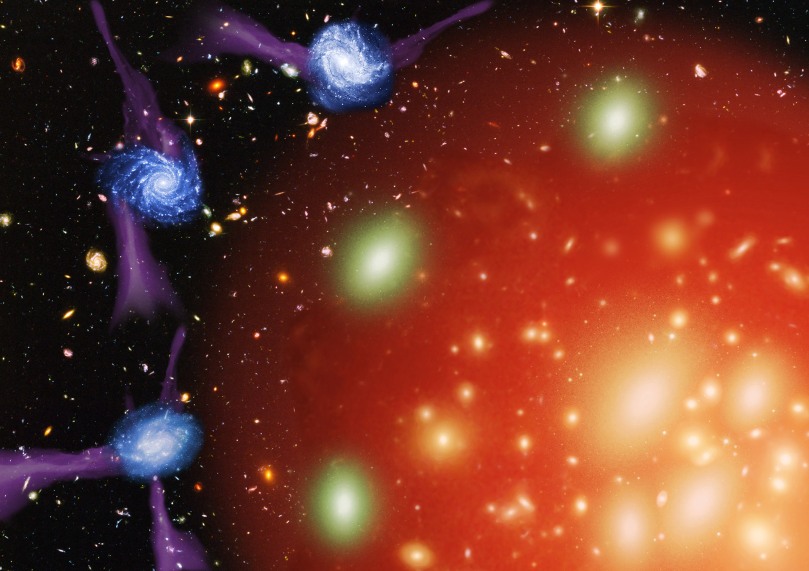
Craftsman’s impression of one of the conceivable galaxy strangulation systems: star-shaping universes (sustained by gas inflows) are accumulated into an enormous hot corona, which “strangles” them and prompts their passing.
Utilizing information from the Sloan Digital Sky Survey, space experts from the University of Cambridge subtle element why certain universes can longer deliver stars.
As homicide secrets go, its a major one: how do cosmic systems pass on and what slaughters them? Another study,published today in the diary Nature, has found that the essential driver of galactic passing is strangulation, which happens after cosmic systems are cut off from the crude materials expected to make new stars.
Scientists from the University of Cambridge and the Royal Observatory Edinburgh have found that levels of metals contained in dead cosmic systems give key ‘fingerprints’, making it conceivable to focus the reason for death.
There are two sorts of universes in the Universe: generally half are “alive” cosmic systems which create stars, and the other half are “dead” ones which don’t. Alive universes, for example, our own particular Milky Way are rich vulnerable gas – generally hydrogen – expected to deliver new stars, while dead systems have low supplies. What had been obscure is what’s in charge of murdering the dead ones.
Cosmologists have think of two fundamental theories for galactic demise: either the icy gas expected to create new stars is all of a sudden “drained” out of the systems by interior or outer strengths, or the supply of approaching chilly gas is some way or another halted, gradually strangling the galaxy to death more than a delayed time of time.
Keeping in mind the end goal to get to the base of this secret, the group utilized information from the Sloan Digital Sky Survey to dissect metal levels in more than 26,000 normal measured cosmic systems situated in our side of the universe.
“Metals are an intense tracer of the historical backdrop of star development: the more stars that are framed by a galaxy, the more metal substance you’ll see,” said Dr Yingjie Peng of Cambridge’s Cavendish Laboratory and Kavli Institute of Cosmology, and the paper’s lead creator. “So taking a gander at levels of metals in dead systems ought to have the capacity to let us know how they kicked the bucket.”
On the off chance that cosmic systems are slaughtered by surges abruptly hauling the icy gas out of the universes, then the metal substance of a dead galaxy ought to be the same as just before it passed on, as star arrangement would unexpectedly stop.
On account of death by strangulation nonetheless, the metal substance of the galaxy would continue rising and in the end stop, as star development could proceed until the current chilly gas gets totally spent.
While it is unrealistic to dissect singular universes because of the huge timescales included, by measurably exploring the distinction of metal substance of alive and dead cosmic systems, the scientists had the capacity focus the reason for death for most worlds of normal size.
“We found that for a given stellar mass, the metal substance of a dead galaxy is fundamentally higher than a star-framing galaxy of comparable mass,” said Professor Roberto Maiolino, co-creator of the new study. “This isn’t what we’d hope to see on account of sudden gas evacuation, yet it is reliable with the strangulation situation.”
The scientists were then ready to freely test their outcomes by taking a gander at the stellar age contrast between star-shaping and dead worlds, free of metal levels, and discovered a normal age distinction of four billion years – this is in concurrence with the time it would take for a star-framing galaxy to be strangled to death, as surmised from the metallicity investigation.
“This is the first definitive proof that systems are being strangled to death,” said Peng. “What’s next however, is making sense of what’s bringing on it. Basically, we know the reason for death, however we don’t yet know who the killer is, albeit there are a couple suspects”
